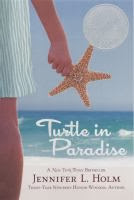Image Source:
Books in Print (via TWU Databases). Accessed November 13, 2013. http://ezproxy.twu.edu:2125/DetailedView.aspx?hreciid=|25425359|23387850&mc=USA
Winner of the Newbery Medal (2010), When You Reach Me by Rebecca Stead is written with a unique style that reflects the thoughts of a young girl expressed in a letter. Miranda is twelve years old, living in New York City, and experiences growth and maturity throughout the novel. In a language that reaches within her innermost thoughts and emotions, the author provides a sense of reflection upon the past with hints toward a future that the reader anticipates with each and every paragraph. The protagonist knows something the reader will only discover upon finishing the novel. This provides the element of anticipation that Stead produces with the unknown recipient of the letter. The reader wants to know more and this is a clever writing technique.
Miranda’s life is a journey into maturity and self-discovery. Her friends Sal, Anne Marie and Julia are also experiencing the growing pains that life brings on a universal level. Young readers will connect with these characters as they are each unique but credible in their own right. The theme includes a need for family, friends, and the attraction that young boys and girls feel toward each other. Serious things occur, as a mentally unstable adult is killed by an automobile while trying to avoid the death of Miranda’s friend Sal. These are topics that young people face and this novel reveals ways in which people react to such tragedies.
Although realistic in many ways, When You Reach Me takes the topic of time travel and presents the concept in a believable fashion. Even as Miranda’s mother prepares to compete on a game show, the reader will find the process engaging and each word leads to more possible endings for the novel. When You Reach Me can be used to allow young readers the opportunity to discuss many topics, including death, friendship, sorrow and hope. As Caitlin Augusta states in her School Library Journal review, “This unusual, thought-provoking mystery will appeal to several types of readers” (Books in Print 2010).
Stead, Rebecca. 2009. When You Reach Me. New York: Random House Children's Books. ISBN 9780385737425
Winner of the Newbery Medal (2010), When You Reach Me by Rebecca Stead is written with a unique style that reflects the thoughts of a young girl expressed in a letter. Miranda is twelve years old, living in New York City, and experiences growth and maturity throughout the novel. In a language that reaches within her innermost thoughts and emotions, the author provides a sense of reflection upon the past with hints toward a future that the reader anticipates with each and every paragraph. The protagonist knows something the reader will only discover upon finishing the novel. This provides the element of anticipation that Stead produces with the unknown recipient of the letter. The reader wants to know more and this is a clever writing technique.
Miranda’s life is a journey into maturity and self-discovery. Her friends Sal, Anne Marie and Julia are also experiencing the growing pains that life brings on a universal level. Young readers will connect with these characters as they are each unique but credible in their own right. The theme includes a need for family, friends, and the attraction that young boys and girls feel toward each other. Serious things occur, as a mentally unstable adult is killed by an automobile while trying to avoid the death of Miranda’s friend Sal. These are topics that young people face and this novel reveals ways in which people react to such tragedies.
Although realistic in many ways, When You Reach Me takes the topic of time travel and presents the concept in a believable fashion. Even as Miranda’s mother prepares to compete on a game show, the reader will find the process engaging and each word leads to more possible endings for the novel. When You Reach Me can be used to allow young readers the opportunity to discuss many topics, including death, friendship, sorrow and hope. As Caitlin Augusta states in her School Library Journal review, “This unusual, thought-provoking mystery will appeal to several types of readers” (Books in Print 2010).
References:
Books in Print (via TWU Databases). Accessed November 13, 2013. http://ezproxy.twu.edu:2125/DetailedView.aspx?hreciid=|25425359|23387850&mc=USA
Stead, Rebecca. 2009. When You Reach Me. New York: Random House Children's Books. ISBN 9780385737425
Stead, Rebecca. 2009. When You Reach Me. New York: Random House Children's Books. ISBN 9780385737425






